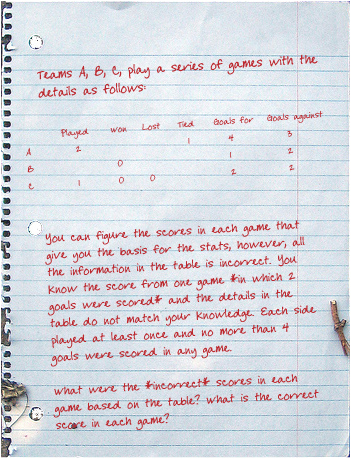
 Congratulations to Susan Russell who receives her atomic wedgie for being so clever, as well as a $50 gift code to ThinkGeek! Check out the solution after the jump and receive a ThinkGeek code for $10 off your next purchase of $40 or more.
Congratulations to Susan Russell who receives her atomic wedgie for being so clever, as well as a $50 gift code to ThinkGeek! Check out the solution after the jump and receive a ThinkGeek code for $10 off your next purchase of $40 or more.
Special thanks to ThinkGeek for providing our prizes!
That’s it. It’s time to prepare the kids for the real world and dump the Lego, the math, the science, and the inventing. You can’t bear the thought of all your kids as nerds and getting picked last for sports –
and sports is the only thing that brings meaning to life. You bring the kids together and announce that they will all be playing hockey from now on and any backtalk will get them an atomic wedgie as punishment.
During your lecture on the finer points of the elegant game of hockey, your youngest is caught passing around a sheet of paper to his siblings. You intercept the sheet to see that he has concocted hockey tables but with a catch:


As you approach your youngest child with your wedgie hand at the ready, your oldest blurts out the answers to the questions from the puzzle.
What were the answers to the puzzle’s questions?
SOLUTION
Your oldest blurts out the matches and scores from the given table as:
A v. B 2–1
A v. C 2–2
The (correct) matches and scores are:
A v. C 0–2
B v. C 3–1
The correct table is as follows:
Played Won Lost Tied Goals for Goals against
A 1 0 1 0 0 2
B 1 1 0 0 3 1
C 2 1 1 0 3 3
As given, C’s match must have been against A and the score must have been 2–2. A’s other game was against B and B lost this game 1–2.
To get the correct table, we must keep aware of the fact that the figures given are wrong.
– A did not play two games; A played one. C did not play one game; C played two. B played one since the total of games must be even.
– C did not win "none" nor lose "none"; C won one game and lost one game. B did not win "none;" B won against C, therefore C won against A. We also know that the goals given are all wrong.
c. Break out what is known so far into tables:
Played Won Lost Tied Goals for Goals against
A 1 0 1 0 not 4 not 3
B 1 1 0 0 not 1 not 2
C 2 1 1 0 not 2 not 2
A B C
A x x L
B x x W
C W L x
The possible scores in B’s match against C (bearing in mind that B did not score 1, and that there were not two goals against) are 2–0; 2–1; 3–0; 3–1. (No more than 4 goals were scored in any game.)
The possible scores in A’s game against C are 0–1; 0–2; 0–4; 1–2.
C’s goals for are not 2 and C’s goals against are not 2. The possible combinations are then:
B v. C 2–0 2–1 3–0 3–1
A v. C – 1–2 0–1 0–2
0–4 0–4
1–2
You are able to derive all the details from your knowledge of the score in a match in which two goals were scored. The only scores with two goals are B v. C (2–0) and A v. C (0–2). There is no possible score which goes with B v. C (2–0) so it must be A v. C (0–2) which then makes the score in B v. C 3–1.
When your oldest gives the answer, you yourself blurt out "April fools" and your children (particularly your youngest) breathe a sigh of relief.
Coupon code PUZZLING will get you $10 off of your next purchase of $40 or more at ThinkGeek.



